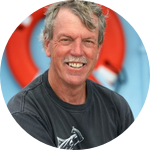About This Project
Marine predators are an important part of our ocean's ecosystems. However, overfishing has reduced predator populations worldwide. My study focuses on one such species: the endangered basking shark. Recent studies have shown a drastic decline in the areas inhabited by basking sharks. Most studies rely on surface sightings to estimate population size, so I want to see if any sharks are hiding beneath the surface by tracking how they move vertically through the water column.
Ask the Scientists
Join The DiscussionWhat is the context of this research?
The world's second-largest shark, the basking shark listed as endangered on the IUCN Red List. They can be seen in areas of the northern Atlantic, slowly filter-feeding on plankton at the surface along the coasts of Ireland and Scotland. These massive creatures (up to 8 meters, or 26 feet, long) have been hunted to near extinction by harpoon fisheries over the past century. What’s more, they now face another challenge: increasing shipping traffic, which can lead to boat strikes.
My project will focus on a basking shark hotspot off the coast of Northern Ireland. A recent population census in this area estimated a drastic decline over the course of just two years, from 985 individuals in 2010 to only 201 individuals in 2011 (Gore et al, 2016).
What is the significance of this project?
While it may seem obvious that this hotspot is in need of government protection, we need to examine the accuracy of these population estimates to determine if we can protect this area as an MPA (Marine Protected Area). Many population estimates depend only on surface sightings. However, it is possible that basking sharks only spend some of their time feeding at the surface. The zooplankton on which they feed can actually be distributed throughout the water column, and the sharks may dive more frequently than we expect to follow these “patches” of prey into deeper water. My goal is to determine how basking sharks move vertically within the water column of the ocean, to see how much time they spend feeding at the surface.
What are the goals of the project?
My goals are simple: 1) I want to examine how basking sharks move vertically through the ocean’s water column. How much time do they spend at the surface, and can we accurately estimate their population based on surface sightings alone? 2) I want to see what factors cause these movements – are the sharks feeding? Are they resting? Do they prefer a certain temperature or pressure? When might they be observed at the surface?
With this information, I will be able to work with policy-makers in the United Kingdom to establish boat practices that limit the possibility of a boat-strike with a surface-feeding shark. It is clear that this is a species in need of protection – we simply need accurate data to determine the best way to do so.
Budget
Fortunately, my laboratory already has access to much of the equipment required for this project, and our collaborators are providing extensive knowledge about tracking basking sharks within this habitat. However, my study requires depth-sensing tags to attach to the individual sharks in order to determine their movement within the water column. Ideally, we would like to tag multiple individuals. My team also requires the use of a boat to follow the sharks as they move. These are the most critical components of my methodology. I am in the process of applying for external funding for the long-term project examining annual trends in habitat use; however, I require funding for a smaller pilot study this coming summer.
Endorsed by
Meet the Team
Affiliates
Dr. Alexandra McInturf
Originally from Cincinnati, Ohio, I graduated Cum Laude from Williams College (MA) with degrees (B.A.) in Biology and English in 2015. I received my PhD in Animal Behavior from the University of California, Davis in 2021. I am currently a CICOES postdoctoral fellow at Oregon State University’s Big Fish Lab.
My research generally focuses on how marine organisms respond to biotic (living) and abiotic (non-living) environmental variables. I use this information to contextualize and predict behavior, movement patterns, and survival. I explore this topic in threatened marine fishes. For my PhD, I studied salmon and sevengill sharks in California and basking sharks in Ireland. I am currently examining the foraging ecology of salmon sharks in Oregon and Alaska and its relative impact on local salmon populations.
Finally, I am an avid science communicator and have developed and led graduate-level courses on this topic. In addition to sharing my SciComm endeavors, I co-coordinate the Irish Basking Shark Group.
Additional Information
I will be working in collaboration with Dr. Jonathan Houghton and his students at Queens University - Belfast, who inspired this in-depth study of the basking shark.
For more information on the Irish Basking Shark Project, led by collaborator Emmett Johnston, visit http://www.baskingshark.ie/
Project Backers
- 55Backers
- 101%Funded
- $4,059Total Donations
- $73.80Average Donation

